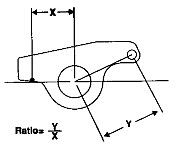71dustar
Well-Known Member
ill be using the eddy alum mag heads and wondering whats the best ratio rocker arms for my 408 engine. what brands do you guys prefer?
A rocker arm is simply a mechanically advantaged lever that translates camshaft data into valve actuation. The mechanical advantage is defined by a rocker's ratio. The standard small-block Chevy (SBC) uses a 1.5:1-ratio rocker arm. In other words, the rocker-arm tip (output) moves 1.5 times the displacement of its pushrod socket (input), or camshaft-lobe lift. The 1.5:1-ratio rocker arm translates 0.350 inches of camshaft-lobe lift into 0.525 inch of valve lift (0.350 inch x 1.5 = 0.525 inch). By increasing the rocker-arm ratio, it's possible to increase valve lift without ever touching the camshaft. A 1.6:1-ratio rocker arm translates the same 0.350 inch of camshaft-lobe lift into 0.560 inch of valve lift (0.350 inch x 1.6 = 0.560 inch). This is a lift increase of about 6.7 percent. Valve lift can typically be increased as much as 10 percent by increasing rocker ratio.

they have 1.6 or the 1.7's from MP. The thing about larger ratio is, however, you could easily hurt your valvetrain geometry with a larger-than-stock ratio, especially if all the rest of the valvetrain components are stock. Here's why:
But because a rocker arm's fulcrum rotates in a radius, this could move your contact point on the valve stem outward, causing a bad contact pattern.

But because a rocker arm's fulcrum rotates in a radius, this could move your contact point on the valve stem outward, causing a bad contact pattern.
Sharpie, The text is correct. I can't see the diagram on my pC at work.. but I can tell you I think youare a little off with this statement. The fulcrum is a single point around which the lever (the rocker) rotates. The radius of the rocker is a straight line drawn accorss the distance from the rocker to valve contact point (roller tip) to the center of the fulcrum point. The pushrod side has it's own radius that is different from the valve side. If the geometry is correct, regardless of the type of rocker (shaft, stud, pedestal) the rocker tip sweeps accross the valve stem tip because the path the tip follows is an arc. What you aim for is at mid lift of the cycle, the radius of the rocker arm is perpenicular to the centerline of the valve stem. Because of the arc's resulting sweep, this means the contact point is at it's furthest point from the fulcrum point, or just off-center of the valve tip towards the exh side (outside) of the head. However, at full lift, the contact point should be centered on the valve tip. This same principal applies to the pushrod side, except the issue is the distance between the pushrod's upper mid-section and the rocker shaft side of the pushrod hole in the head. As the rocker is pushed up, the cup effectively moves in towards the rocker and the pushrod rubs. The higher the rocker ratio and higher the lift, the more likely the problem will occur.
